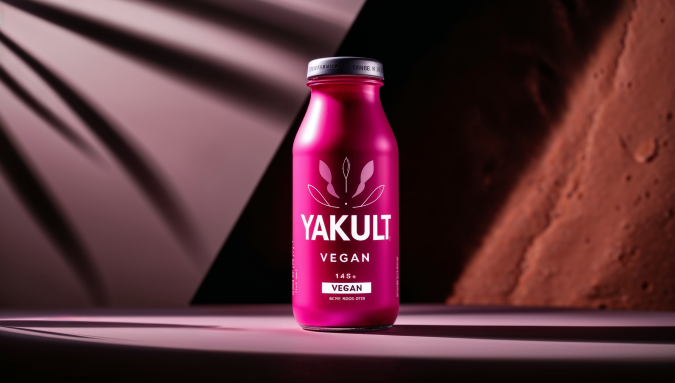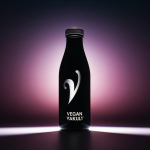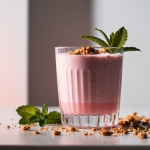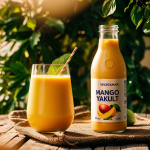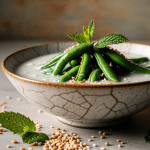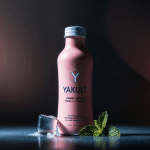To create a vegan version of Yakult that closely resembles the original in taste and texture, follow this detailed recipe. It utilizes plant-based ingredients while ensuring you get the probiotic benefits similar to traditional Yakult.
Best Vegan Yakult Recipe
Ingredients
- 1 liter of unsweetened almond milk or soy milk (choose based on preference)
- 2 probiotic capsules (ensure they contain live cultures; look for strains like Lactobacillus acidophilus or Bifidobacterium bifidum)
- 2 tablespoons of maple syrup or agave nectar (adjust to taste for sweetness)
- 1 teaspoon of vanilla extract (optional, for added flavor)
- Juice of 1 lemon (for tanginess)
Instructions
Prepare the Milk Base:
- In a saucepan, gently heat the almond or soy milk until it reaches about 40°C (104°F). Do not let it boil, as high temperatures can kill the probiotics.
Add Probiotics:
- Open the probiotic capsules and sprinkle the contents into the warm milk. Stir gently to combine without creating too many bubbles.
Sweeten and Flavor:
- Add maple syrup or agave nectar, lemon juice, and vanilla extract (if using) to the milk mixture. Stir well until everything is fully dissolved.
Fermentation Process:
- Pour the mixture into a clean glass jar or container. Cover it with a cheesecloth or a clean kitchen towel to allow airflow while preventing contaminants.
- Place the jar in a warm spot (ideally around 37°C or 98°F) for about 24-48 hours. The longer it ferments, the tangier it will become.
Check Consistency and Flavor:
- After fermentation, check the taste and consistency. If you prefer it tangier, let it ferment longer. The final product should be slightly thicker than regular milk with a mild tangy flavor.
Refrigerate:
- Once you achieve your desired flavor, stir the mixture again and transfer it to the refrigerator. Chill for at least 4 hours before consuming.
Serve:
- Shake well before serving. Enjoy your homemade vegan Yakult as a refreshing drink!
Storage
Store your vegan Yakult in the refrigerator for up to one week. Always check for any off smells or changes in texture before consuming.
Tips for Best Results
- Probiotic Selection: Ensure that your probiotic capsules contain live cultures and are suitable for vegan diets.
- Adjusting Sweetness and Tanginess: Feel free to adjust the amount of sweetener and lemon juice according to your taste preferences.
- Fermentation Environment: A consistent warm environment is crucial for effective fermentation; consider using an oven with just the light on or a yogurt maker if available.
Best Non-Dairy Milks for Vegan Yakult
When making a vegan version of Yakult, the choice of non-dairy milk is crucial for achieving a similar taste and texture to the original. Here are some of the best options:
- Soy Milk: Rich in protein and has a creamy texture, making it one of the best substitutes for dairy milk. Look for unsweetened varieties to control sweetness.
- Almond Milk: Light and slightly nutty, almond milk can work well, especially if you prefer a lighter drink. Choose a brand that is fortified with calcium and vitamin D.
- Coconut Milk: Full-fat coconut milk provides a rich, creamy texture and adds a slight coconut flavor, which can enhance the overall taste.
- Oat Milk: Creamy and naturally sweet, oat milk can be an excellent choice for those looking for a thicker consistency.
- Cashew Milk: Similar to almond milk but creamier, cashew milk can also provide a rich base for fermentation.
Tips for Thickness
To achieve a thickness similar to original Yakult, consider using full-fat coconut milk or adding a thickening agent like xanthan gum or agar-agar during the blending process.
Making Vegan Yakult Thick
To make your vegan Yakult as thick as the original, follow these tips:
- Use Creamy Non-Dairy Milk: Opt for full-fat coconut milk or soy milk for a richer texture.
- Add Thickeners: Incorporate thickeners such as:
- Xanthan Gum: Start with 1/4 teaspoon mixed into the milk before fermentation.
- Agar-Agar: Dissolve it in boiling water according to package instructions before adding it to your mixture.
- Longer Fermentation Time: Allow the mixture to ferment longer (up to 48 hours) at a consistent warm temperature to develop thickness.
Probiotic Powders for Vegan Yakult
When selecting probiotic powders for your vegan Yakult, look for those that contain live cultures specifically suited for plant-based diets. Some recommended strains include:
- Lactobacillus acidophilus
- Bifidobacterium bifidum
- Lactobacillus plantarum
These strains are effective in promoting gut health and can be found in various vegan probiotic supplements.
Using Probiotic Supplements Instead of Fermented Milk
Yes, you can use probiotic supplements instead of fermented milk to make vegan Yakult. This method allows you to bypass the need for any dairy or dairy-like fermentations while still achieving beneficial probiotic content. Simply open the capsules and mix their contents into your non-dairy milk base as described in your recipe.
Tips for Achieving Tanginess
To ensure your vegan Yakult has the same tanginess as the original, consider these tips:
- Incorporate Lemon Juice: Add fresh lemon juice (about 1 teaspoon per liter) to enhance tanginess during mixing.
- Fermentation Duration: Allow longer fermentation times (24-48 hours) at stable warm temperatures to develop more acidity.
- Use Quality Probiotics: Select high-quality probiotics known for producing lactic acid during fermentation, as this contributes to tanginess.
By following these guidelines, you can create a delicious and tangy vegan Yakult that closely resembles the original beverage while maintaining its health benefits.
This recipe aims to replicate the sweet and tangy flavor profile of traditional Yakult while being completely plant-based, making it a delicious alternative for those following a vegan lifestyle.
